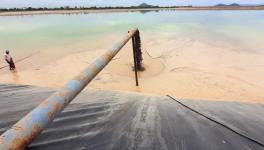Fish in Bengaluru Lakes Continue to Die of Asphyxiation; 8 Fishkills Already This Year
Representational use only.Image Credit: Istock Photo
Bengaluru: Fishkills in Bengaluru are on the rise. A fishkill is an unexpected mass death of fish in a relatively short span of time. In 2022 alone, eight fishkills have already occurred in various lakes in the city, which is the highest in six years, according to a new report by ActionAid, an international non-governmental organisation.
The report, Fishkill in Lakes of Bengaluru (2017-2022), observed that the primary cause of fish death was the dumping of untreated sewage into the water. The organic matter in sewage uses up all the dissolved oxygen in water, which leads to suffocating the fish to death. This tragedy highlights the burden being borne by nature to support the unsustainable expansion of our cities.
Bengaluru was once home to over a 1,000 lakes. However, due to rapid urbanisation and residential encroachment, less than 300 lakes remain now. The numbers are rapidly shrinking and the lakes that exist, are full of pollutants.
The Action Aid report observes that the fishkill in lakes is also being caused by dumping of chemicals, industrial effluents, pesticides, and fertilisers from adjoining agricultural areas.
Four lakes have been identified as particularly vulnerable and prone to fishkill - Haralur lake, Madiwala lake, Bellandur lake and Kommaghatta lake. Alarmingly, since 2017, there have been 32 incidents of fishkill in the city. The most recent example was in Thubarahalli lake in July 2022.
Further, there has been no investigation or action by the Karnataka State Pollution Control Board (KSPCB) or the Bruhat Bengaluru Mahanagara Palike (BBMP). Only one report was found on the Central Pollution Control Board’s (CPCB) website on the Ulsoor Lake Fishkill in 2016. A report on asphyxiation of fish was also conducted by the Indian Institute of Science (IISC) researchers who investigated the fish and water samples in 2016.
Civic activist Raghavendra Pachhapur told NewsClick over the phone that “asphyxiation can also be caused by a process called Eutrophication. When pollutants are dumped in a water body, there is a sudden build-up of nutrients in the form of phosphorus and nitrogen, which result in the growth of algae and water hyacinth. When the algae eventually die, its decomposition process sucks up all the dissolved oxygen in the water. The presence of excess algae and water hyacinth makes it impossible for the fish to survive”.
While the BBMP is responsible for the maintenance of 210 lakes in the city, Mohan Krishna, the Chief Engineer (Lakes),while speaking to NewsClick, admitted that only 186 live lakes are currently being managed by the Palike. The other lakes have ‘disappeared’ due to encroachments, he said.
In the past, several residential projects have been illegally constructed on the lake beds. As lakes dry up, spaces open up for new, illegal residential projects. However, these areas are prone to flooding during heavy rains.
Krishna said illegal encroachments (gated apartments and slums) can be surveyed and removed only by the Revenue Department or the Deputy Commissioner. Multiple departments must work together if the lakes are to survive.
In 2016, the National Green Tribunal (NGT) passed an order to enlarge the buffer zone around the lakes from 30mt. to 75mt. Construction activities were banned within the buffer zone. In 2019, the Supreme Court set aside the order after the Karnataka government appealed against the NGT ruling.
BBMP Holds Public Meeting On Lake Rejuvenation
On July 13, 2022, the BBMP held a public meeting for suggestions on the rejuvenation of 14 lakes under the Chief Minister Amrutha Nagarothana Yojana programme. However, as the programme was held on a weekday, participation was limited to local Resident Welfare Association (RWA) members and birders. Two external consultants have also been roped in by the BBMP to create a Detailed Project Report on rejuvenation. Their presentations were also made available to the public.
In the meeting, citizens who live near the lakes in question, expressed their concerns and made suggestions. Several issues were repeatedly brought up, such as plastic and garbage dumping, drying up of lakes, illegal encroachment, dumping of sewage, and absence of regular monitoring or maintenance by BBMP.
Krishna, while speaking with NewsClick, blamed the sewage dumping on the Bangalore Water Supply and Sewerage Board (BWSSB). “There cannot be a sewage treatment plant (STP) in every lake because the maintenance of that infrastructure would become expensive. Moreover, there is an NGT order against lake constructions. The BWSSB should ensure that all the sewage is treated before it enters the lake, or the sewage should be diverted elsewhere,” he said.
When this reporter asked him where else the sewage could be diverted, he said: “In another lake. Still, BWSSB should treat the water before it reaches there”.
While the BBMP Chief Engineer insisted that sewage flow has been cut off to prevent repeated incidents of fishkill in the same lake, the Action Aid report says otherwise. Haralur Lake and Madiwala Lake have recorded multiple fishkills in 2017, 2018 and 2019.
The report also has several recommendations -- regular public meetings, publishing of the minutes on the BBMP website, documentation of biodiversity and the lake ecosystem in order to initiate conservation efforts, removal of encroachments and planting of trees around the lake to reduce nutrient load.
Get the latest reports & analysis with people's perspective on Protests, movements & deep analytical videos, discussions of the current affairs in your Telegram app. Subscribe to NewsClick's Telegram channel & get Real-Time updates on stories, as they get published on our website.
























